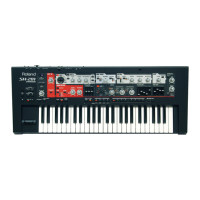
Do you have a question about the Roland SH-201 and is the answer not in the manual?
| Synthesis Type | Virtual Analog |
|---|---|
| Oscillators | 2 per voice |
| Waveforms | Saw, Square, Pulse, Triangle, Sine, Noise |
| Arpeggiator | Yes |
| Keyboard | 49 keys |
| MIDI | In, Out |
| USB | Yes |
| Release Year | 2006 |
| Effects | Reverb, Delay, Chorus |
| LFO | 1 |
| Audio Outputs | Stereo (L/MONO, R) |
| Headphones | 1/4" stereo phone jack |
| Filter | Resonant Low-Pass, High-Pass, Band-Pass |
| Weight | 5.0 kg |
Describes the controls and features on the top surface of the SH-201 synthesizer.
Details the connectors and ports located on the back of the SH-201 synthesizer.
Instructions for connecting the SH-201 to external devices and power sources.
Steps to properly connect the included AC adaptor to the SH-201 unit.
Guidance on connecting audio output devices like headphones or speakers to the SH-201.
Procedures for safely powering the SH-201 synthesizer on and off.
Explains the part of the SH-201 responsible for user input and performance control.
Details the component that produces the actual audio waveforms and sound.
How to control the overall output volume of the SH-201 using the Master Volume knob.
Guide to choosing and selecting available patches or sounds on the SH-201.
Explains the concept of patches, preset and user groups, and banks on the SH-201.
Instructions for returning user-created patches and settings to factory defaults.
How keyboard playing dynamics affect volume and brightness changes.
Using the pitch bend lever to alter pitch and add vibrato effects.
Creates a smooth transition between notes for a gliding pitch effect.
Using the D Beam controller to dynamically change pitch or volume.
Using a pedal to sustain notes after releasing the keys.
Using the built-in arpeggiator to create automatic arpeggiated patterns.
Capturing keyboard performances and knob operations as phrases.
Instructions on selecting, starting, and stopping playback of recorded phrases.
How to choose which recorded phrase to play back.
Explains the fundamental process of sound generation using oscillators, filters, and amplifiers.
How envelopes shape sound parameters like pitch and volume over time.
Selecting oscillator waveforms and setting the fundamental pitch of sounds.
Shaping how pitch changes over time from note onset to decay.
Layering or synchronizing OSC 1 and OSC 2 for complex and rich sounds.
Adjusting the sound's brightness and tonal character using the filter section.
Shaping how filter cutoff frequency changes over time for tonal evolution.
Controlling the sound's volume level and how it changes over time.
Adding a distorted, thick, and powerful character to the sound.
Using Low Frequency Oscillators to create cyclic changes in sound parameters.
Assigning parameters like Pitch, PW, or Filter to be modulated by LFO 1.
Assigning parameters like Pitch, PW, or Amp to be modulated by LFO 2.
Applying Delay and Reverb effects to enhance sound depth and ambiance.
Layering or splitting sounds for richer and more versatile performances.
Instructions for saving custom-created sounds as user patches.
Steps for connecting external audio sources like players or samplers.
Controlling the volume of the external audio source connected to the INPUT jacks.
Applying filters to shape the tone of external audio sources.
Using the SH-201 keyboard to control external audio sources as if they were oscillators.
Connecting the SH-201 to a computer via USB for recording and playback.
Steps for installing the necessary software driver for USB connectivity.
Using software to edit sounds and manage patches more effectively.
Lists the minimum system specifications needed for the SH-201 Editor software.
Connecting and utilizing the SH-201 with other MIDI devices.
Controlling the SH-201's sound generator with an external sequencer.
Detailed list of parameters for oscillator mixing and modulation.
Detailed list of parameters for filter and amplifier sections.
Detailed list of parameters related to Low Frequency Oscillators (LFOs).
Detailed list of parameters for Delay and Reverb effects.
Common parameters that apply to all patches.
Parameters for assigning controller functions like Modulation and D Beam.
Detailed list of parameters for configuring the arpeggiator.
Global system settings affecting the entire SH-201 unit.
Parameters controlling keyboard behavior, transpose, and local control.
How to define the point on the keyboard where the split function takes effect.
Mapping MIDI control change messages to SH-201 parameters.
A technical chart detailing MIDI message support for the SH-201.
Technical details and features of the SH-201 synthesizer.
